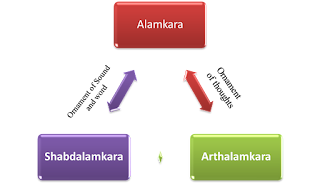This blog is reaponse of Thinking Activity given by Professor Dr. Dilip Barad sir here I discuss about what is Indian Poetics explained by Professor Vinod Joshi sir.
Indian Poetics
There is one major difference between Indian Poetics and Western theory of criticism and that is...
"Western Criticism deals with the influence of the work of art and it's Ultimate Aim. While Indian Criticism deals with the process of work of art. In the world Criticism Indian Criticism is Unique."
Bharata is the first among all critics who pioneered in Indian aesthetics. Some of the noteworthy critics of Sanskrit Literature.
The Six Schools and the pioneers:
- Rasa - Bharat
- Alamkara - Bhamaha
- Riti - Vamana
- Dhvani - Anandvardhan
- Vakrokti - Kuntaka
- Auchitya - Kemendra
રસ સંપ્રદાય ( Rasa Theory)
What is RASA?
“A blending of various Bhavas arise certain emotion, accomplice by thrill and a sense of joy is Rasa.” In the sixth chapter of Natyashashtra he explains NATYARASA and RASA as the soul of poetry.
"विभावानूभावव्यभिचारी संयोगात रस निष्पति।।"
Rasa is created only because of Vibhav , Anubhav and Vyabhicharibhava. VIBHAV is just like pilar of it and because of it Bhvak feels Rasa.Bharatmuni describes 33 Sancharibhava in Natyasastra.
Vibhav : Emotion arise because of Vibhav
Anubhav : Reaction of Bhavak
Sancharibhav : Come and go
Sthayibhav : like…. Love, Mirth, Sorrow
ભાષ્યકારો:
આ ભાષ્યકારોના મતે ભાવ ક્યાં ઉત્પન્ન થાય છે?
૧,ભટ્ટ લોલ્લટ(ઉત્પત્તિવાદ)
ભટ્ટ લોલ્લટનુ માનવું છે કે નાટકમાં રસ હોતો નથી પણ તેને ઉત્પન્ન કરવો પડે છે.અને તે નટ અને નટીમા ઉત્પન્ન કરવાનો હોય છે.
૨,શ્રીશંકુ (અનુમિતિવાદ)
ચાર પ્રકરની પ્રતીતિઓ દ્વારા આપણે રસનું અનુમાન કરવું પડે અથવા તો રસ અનૂમાનિત થાય છે. ૧, સમ્યક પ્રતિતી, ૨, મિથ્યા પ્રતીતિ,૩, સંશય પ્રતીતિ, અને ૪, સાદ્રશ્ય પ્રતીતિ.
૩, ભટ્ટ નાયક (સાધારણીકરણીયવાદ)
જે ભાવ નટ અને નટી અનુભવે તે ભાવ નો અનુભવ જ્યારે પેશ્રકો ને થાય ત્યારે રસનો અનુભવ થાય છે.
૪, અભિનવ ગુપ્ત (અભિવ્યક્તિવાદ)
प्रकाशनंदज्ञानम प्रितितीમા તેમણે કહ્યું કે, જે કાવ્ય રચના સંપૂર્ણ પણે ભાવનો આનંદ કરાવે તેનુ નામ રસ.
ધ્વનિ સંપ્રદાય (Dhvani Theory)
Anandvardhan's theory of Dhvani has changed Indian Poetics in its essanse. The word Dhvani means 'sound' or 'tone'. In language sound carries a meaning. A word in its basic grammatical sense is a combination of letters. The Sanskrit grammarians argue that the letters are not the ultimate cause of meaning. Thus they discovered a distinct entity called sphota(sign). They argue that meaning is indeed signified by the sound which becomes the meaning of the word.
ધ્વનિમાં ભાષા હોય છે અને રસમાં ભાષા હોતી નથી ભાવ હોય છે.
આનંદવર્ધનને 'ધ્વન્યાલોક' નામનો ગ્રંથ લખ્યો છે જેમાં તેમણે ધ્વનિ ને કાવ્યનો આત્મા કહયો છે.
The Central idea of the heory of Dhvani is that words in their capacity of conveying sense. He talk about threefold sense which are અભિધા(denotation), લક્ષણા (indication), વ્યંજના (suggestion).
અભિધા
Take direct meaning
એક બિલાડી જાડી - અભિધા
લક્ષણા
If we don't get direct meaning then need to take nearby meaning
તેણે પહેરી સાડી - લક્ષણા
વ્યંજના
We can get direct meaning but need to take another meaning
તળાવમાં તો મગર - વ્યંજના
વક્રોક્તિ( Vakrokti Theory)
वेदण्ध्यभंगीभणीती इति वक्रोक्ति "
(વિશિષ્ટ્ટ રીતે કહેવાતુ હોય તેે વક્રોક્તિ)
શબ્દ અને અર્થમાં વક્રોક્તિ હોય એટલે સાહિત્ય સુંદર અને ઉત્તમ બને. વક્રોક્તિ માં શબ્દ પર સ્થિર થવાનુ ,અર્થ પર સ્થિર થવાનુ ભાવ પર નહીં. સૌંદર્ય અનુભવાય ત્યારે સાહિત્ય સાર્થક થાય છે.
કુન્તકે વક્રોક્તિના છ પ્રકાર પાડયા છે:
- વર્ણ વિન્યાસ વક્રતા: એકનો એક શબ્દ વારંવાર આવે તે.
- પદ પૂર્વધ વક્રતા: પદની પહેલાં આવતું પદ.
- પદ પરાર્ધ વક્રતા: પદ પછી આવતું પદ.
- વાક્ય વક્રતા: એક વાક્ય જે ન્યાય રૂપ બની શકે .
- પ્રકરણ વક્રતા: કોઈ એક પ્રકરણ પર લખાતું સાહિત્ય.
- પ્રબંધ વક્રતા: આખાય પ્રબંધ નો લક્ષ સૂચવે
અલંકારસંપ્રદાય(Vakrokti Theory)
Bhamaha is the first who introduced alamkara poetics. Human being used to wear Ornaments to look beautiful in the same manner, poet use Figures of Speech to make their work attractive. Ornaments is necessary but not compulsory. In literature Alamkara is very important.
ભામહે અલંકારશાસ્ત્ર ગ્રંથ આપ્યો તેમાં અલંકાર વિશે વિસ્તૃત વર્ણનો આપ્યા છે. અલંકાર અને ભાષા બંને applied હોય છે.અલંકાર કુદરતી કે જન્મજાત નથી હોતો. દમયંતી નું મુખ ચંદ્ર જેવું છે. એ અલંકાર થી ભરેલ વાક્ય છે. અલંકાર હંમેશા શબરો સાથે ઓતપ્રોત હોવો જોઈએ, અડોઅડ નહિ. કાવ્યમાં અલંકાર હોય પણ ક્યારેક ના હોય તો પણ ચાલે. સરલ અલંકાર, નિરલંકાર જેવા પ્રકારો ભામહે આપ્યા છે.
રીતિ સંપ્રદાય( Riti Theory)
'रीतिरात्मा काव्यस्य; विशिष्टापदरचना रीति: |'
Riti stands for the different styles of writing each of which portrays a different emotion. Riti is a theory of language of literature. Riti is described for the first time in Bharata's Natyashastra itself under the rubric of vrtti, it is Vamana who developed it into a theory. Vamana believes that Riti is a soul of poetry-- " ritiratma kavyasya".
રીતીના પ્રકાર
૧, પ્રદેશ પ્રમાણે
૨, ભાષા પ્રમાણે (વેદૅભી, ગૌડી, પાંચાલી)
૩, સ્વભાવ પ્રમાણે
ઔચિત્ય સંપ્રદાય (Aucitya Theory)
Kshemendra’s discussions of the principle of Aucitya is from the point of view of both the writer and the reader and is articulated in its given cultural and philosophical context. Kshemendra made aucitya spine elements of literarinmess. He defines aucitya as the property of an expression being an exact and appropriate analogue of the expressed.
ઔચિત્ય એ સાહિત્યનું સૌથી પધાન લક્ષણ છે.
Example:
તને દોડીને ભેટવાનું મન ઓ શ્યામ....
પણ તું અલગો તો થા.....
Sir also discussed that We can see this aucitya with the connection of The Old man and the Sea by Ernest Hemingway and Myth of Sysiphus by Albert Camus.
In brief we can say that Indian Poetics is a never-ending topic. It’s like an ocean. It gives a very immense idea about Sanskrit literature.
Thank you











No comments:
Post a Comment